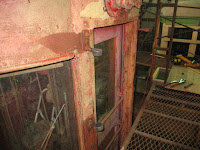Today was productive, and perhaps more importantly, educational. I learned a few new things about body and fender work from Gerry, and it's always good to have some useful skills, even if you're already retired. You never know when a new career path might be necessary nowadays.
I was busy enough that I only got one picture of other people at work. Here Tim is stripping paint off the toilet door from the 50th Avenue station in order to get at paint samples. He says he will be making a new door to replace it.
And John and Gerry were working as usual on the 306.
To start with, I painted the 453's horns black, as seen here. I heard rumors to the effect that the shop guys want to disassemble them to check the mechanisms, but I don't think a finish coat of paint will get in the way.
On the whole, the structure of the 453 is in very good condition. There is no detectable body rust throughout the car, with the exception of the panel above one end window at the #1 end, as seen here. So I asked Gerry to look at it and determine if we needed to weld in new steel.
He decided that welding was not necessary, and with sufficient preparation we could fill the holes with body filler and that would do the job. So I started by needle-chipping the affected area.
While I was up there, I also noticed a smaller area to the left of the jumpers that needed work.
And the needle-chipping was followed by pounding with a hammer and grinding:
and then wire-wheeling.
There's also a rusted panel inside the vestibule, immediately behind the area shown above:
I was unable to remove the flag box with the available tools, but this can probably be done next time. Then this area will get a similar treatment.
Tim recommended the use of epoxy to fill the holes, so I started with a first application of solid epoxy that we've used before. Although it's rather cold, the epoxy will just take longer to set up.
And next time I'll start sanding it smooth.
The next exciting project was removing the bent hand rails from the end of the car, victims of the collision that also punched a big hole in the end of the roof at Trolleyville. We've seen a few pictures of this before. Gerry helped by heating up the nuts and the brackets as needed to remove the old handrails. I was too busy helping to get any pictures of the process, but they are both now removed.
The handrails consist of a steel rod about 1/2" or so in diameter, covered with an unusual substance as seen here. Tim says it's phenolic.
While steel rod is not hard to get, I have as yet no idea whether this phenolic stuff is available, or what we could use as a substitute. Other things could presumably work as well, as long as they don't twist on the steel rods. I left the remains on the workbench for the department gurus to ponder. Notice that the material appears to be in concentric layers.
And as I say, the damaged rails are now gone.
So that represents quite a bit of progress for one day. And in other thrilling news, I'm told that our new canvas, along with a canvas order for the Pennsy bobber, was shipped today from our supplier in Chicago. So that's something to look forward to. Dave Diamond has provided me with a large tub on wheels to soak the canvas in, so I can start on that part of the project whenever the canvas actually arrives. Stay tuned!















4 comments:
Randy- Tim's right, it appears to be some sort of phenolic tube, maybe Micarta or the like. It's commonly available and not particularly expensive. It's not always a good choice for outdoor/wet environments, but if you paint it thoroughly, it should do fine in our service. I'll have a look at it this weekend.
R. W. Schauer
Looks like a company in Lake Forest is a good Micarta supplier. They seems to have some experience with the railroad industry as well, although they weren't around when that car was built. https://kor-pak.com/product-category/micarta-and-phenolic-laminates/
Thanks for the information. I feel better already. But we will need to make sure somehow that the tube doesn't rotate on the steel rod, and that may be a problem. I don't know why this construction was thought necessary - the earlier cars get by just fine with ordinary grab irons.
Is the new ticket office for the 50th Avenue station based on plans or historic photographs?
It is a great piece of cabinet making!
Ted Miles, 2021 member
Post a Comment